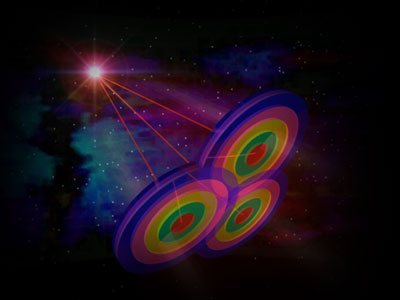ONE FAMILY PLAN
Hologram
"A hologram is produced when a single laser light is split into two separate beams. The first beam is bounced off the object to be photographed. Then the second beam is allowed to collide with the reflected light of the first. When this happens they create an interference pattern which is then recorded on a piece of film. To the naked eye the image on the film looks nothing at all like the object photographed. In fact, it even looks a little like the concentric rings that form when a handful of pebbles is tossed into a pond. But as soon as another laser beam (or in some instances just a bright light source) is shined through the film, a three-dimensional image of the original object appears." (Michael Talbot, The Holographic Universe, p 14-15)
If the film is divided again and again, the full object can still be reconstructed from each tiny portion of the whole, though the images get hazier as the portions become smaller. Each piece contains all the information recorded in the whole. In the same manner it would appear equally possible for all parts of the brain to contain all information necessary to recall a whole memory. Vision may also be distributed throughout. Pribram spent years measuring the electrical activity in the brains of monkeys while they performed various visual tasks and found that one-to-one correspondences (image to specific location in brain) did not exist. No discernable pattern existed to the sequence in which the electrodes fired. He wrote, "These experimental results are incompatible with a view that a photographic-like image becomes projected on the cortical surface." He felt the "whole in every part" nature of the hologram explained how the visual cortex could be removed without affecting ability to perform visual tasks. A small piece of the hologram would still be able to reconstruct the whole of what the eyes were seeing.
But what wave-like phenomenon could be used to create such a hologram? The electrical communications that occur between the brain's nerve cells, or neurons, do not occur alone. "Neurons possess branches like little trees, and when an electrical message reaches the end of one of these branches it radiates outward as does the ripple in a pond. Because neurons are packed together so densely these expanding ripples of electricity - also a wavelike phenomenon - are constantly crisscrossing one another." (Talbot, p 20) Pribram observed, "The hologram was there all the time in the wave-front nature of brain-cell connectivity... We simply hadn't had the wit to realize it."
"When we are unable to recall something, this may be equivalent to shining various beams on a piece of multiple-image film, but failing to find the right angle to call up the image/memory for which we are searching." (Talbot, p 21)
As we view a person, the image rests on the surface of our retinas, yet we feel as though the person is on our retinas, as perceived in the "world-out-there." If we stub our toe, the pain is in the brain but we feel it in our toe. The brain seems to take our experiences, all internal, and make us believe that some are internal and some beyond.
David Bohm is a University of London physicist... He believes ...the reason subatomic particles are able to remain in contact with on another regardless of the distance separating them is not because they are sending some sort of mysterious signal back and forth, but because their separateness is an illusion. He argues that at some deeper level of reality such particles are not individual entities, but are actually extensions of the same fundamental something."(Michael Talbot)
"Scientists are beginning to believe the universe itself is a kind of giant hologram, a splendidly detailed illusion no more or less real than the image of Princess Leia that starts Luke on his quest. Put another way, there is evidence to suggest that our world and everything in it - from snowflakes to maple trees to falling stars and spinning electrons - are also only ghostly images, projections from a level of reality so beyond our own it is literally beyond both space and time." (Michael Talbot)
"A hologram is, in a sense, a quantum filing cabinet, in which information is enfolded - stored - in quantum waves. In a classic laser hologram, a laser beam is split... Bohm considered the universe a giant information headquarters of 'unbroken wholeness,' in which everything in the universe is already present in some invisible domain beyond time and space - a field of all possibility -there to be called forth and made 'explicate,' or manifest, when necessary." (Lynne McTaggart)
"Everything interpenetrates everything, and although human nature may seek to categorize and pigeonhole and subdivide, the various phenomena of the universe, all apportionments are of necessity artificial and all of nature is ultimately a seamless web… Despite its apparent solidity, the universe is at heart a phantasm, a gigantic and splendidly detailed hologram." (Michael Talbot)
"The 'all in the small' was the aspect of holography that most fascinated Talbot - the idea that each tiny portion of the encoded information contains the whole of the image. If you were to chop up your photographic plate of Princess Leia into tiny pieces, and shine a laser beam on any one of them, a full image of the princess would emerge." (Lynne McTaggart)
"One of the things that makes holography possible is a phenomenon known as interference. Interference is the crisscrossing pattern that occurs when two or more waves, such as waves of water, ripple through each other... two sets of waves that expand and pass through one another... known as an interference pattern... Because laser light is an extremely pure, coherent form of light, it is especially good at creating interference patterns. It provides, in essence, the perfect pebble and the perfect pond." (Talbot, p 14)




